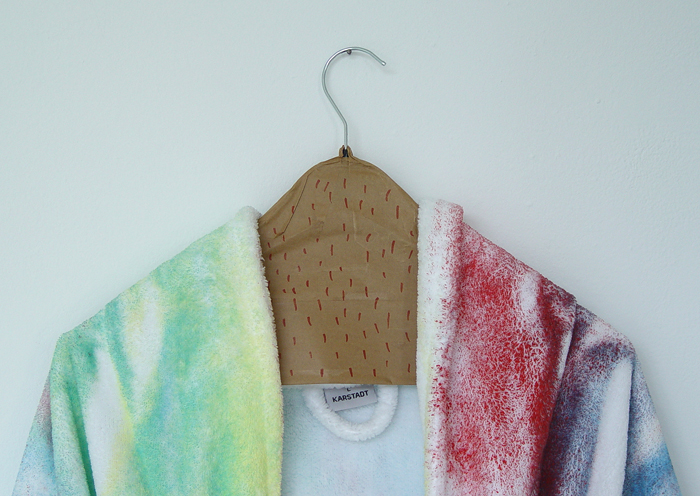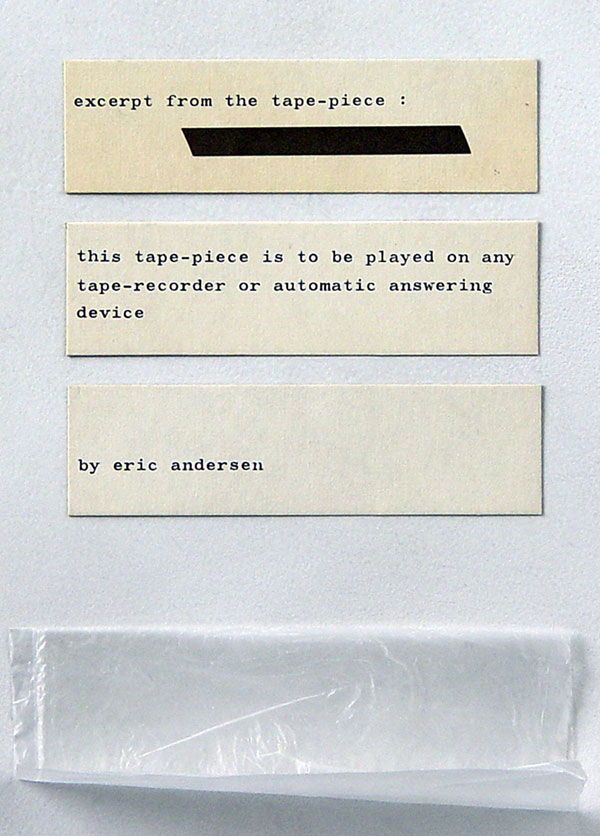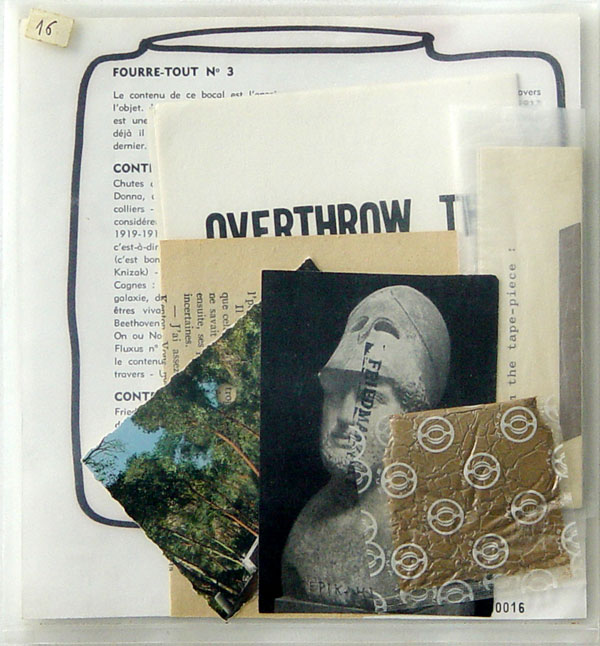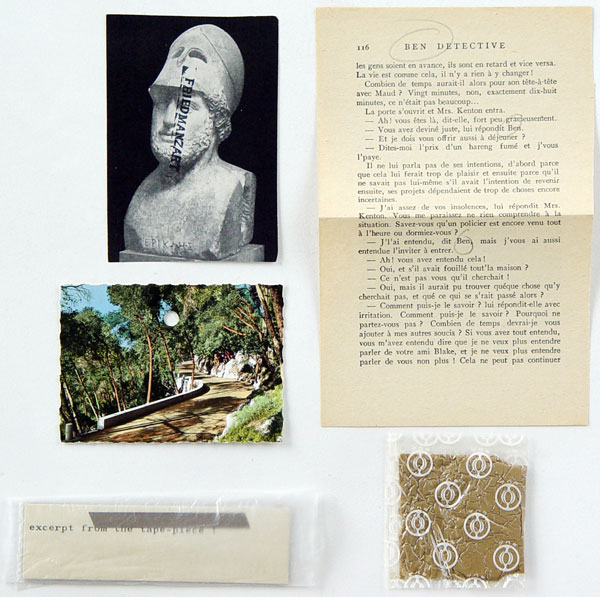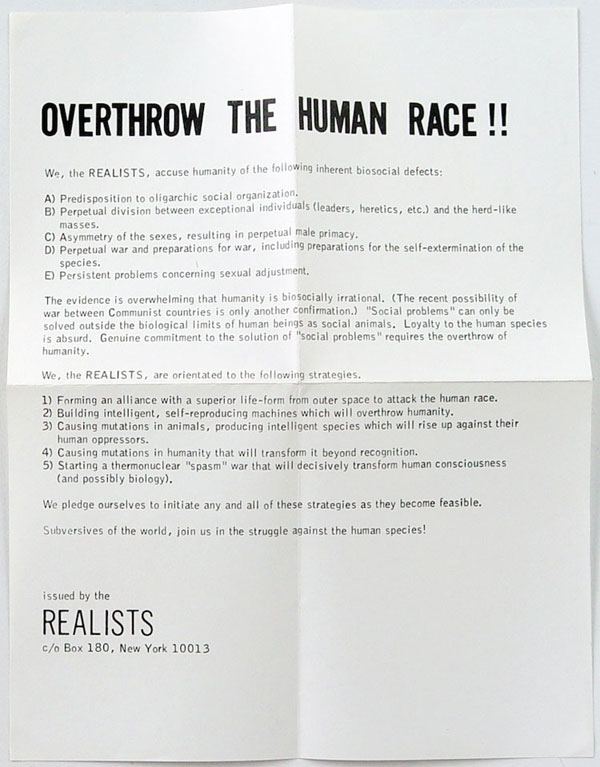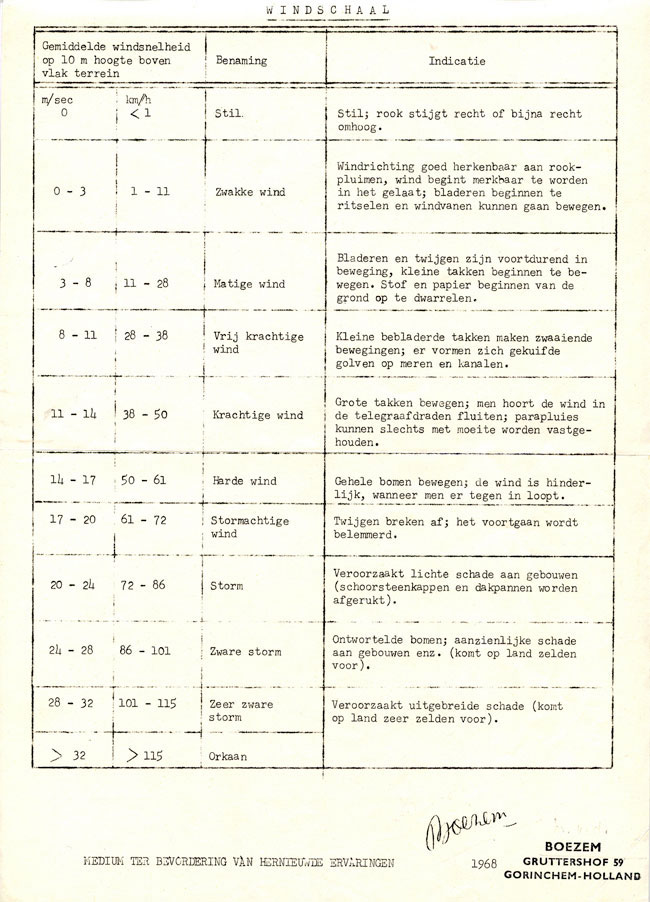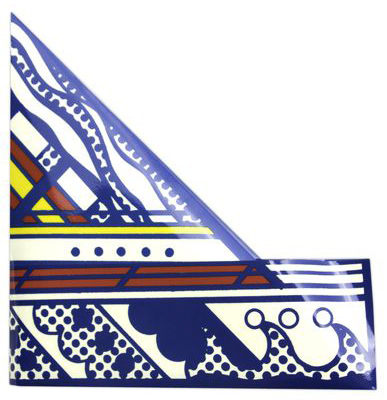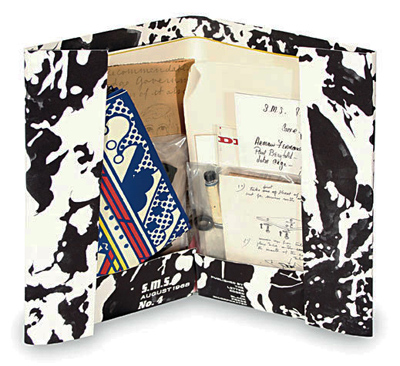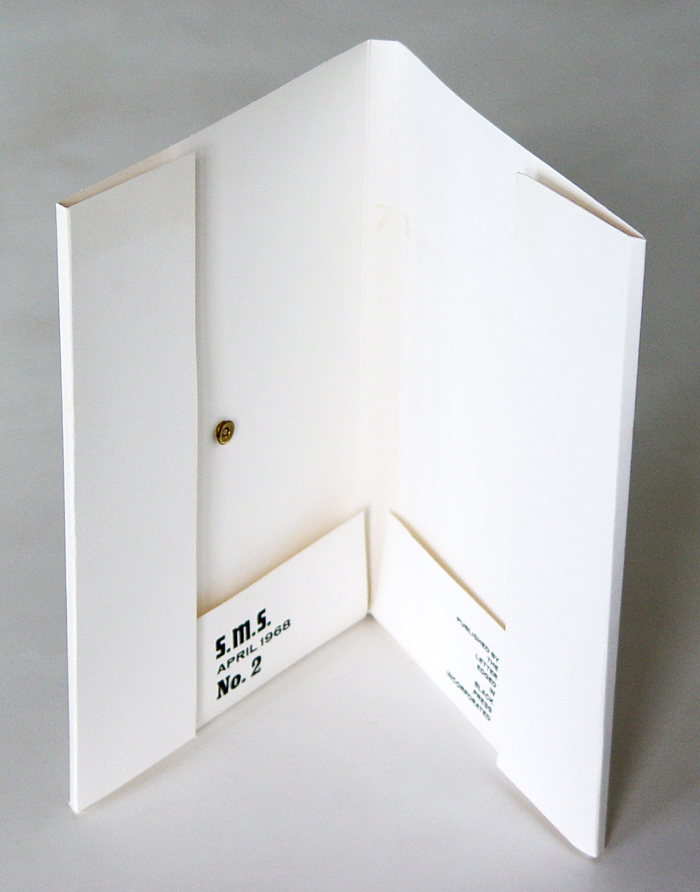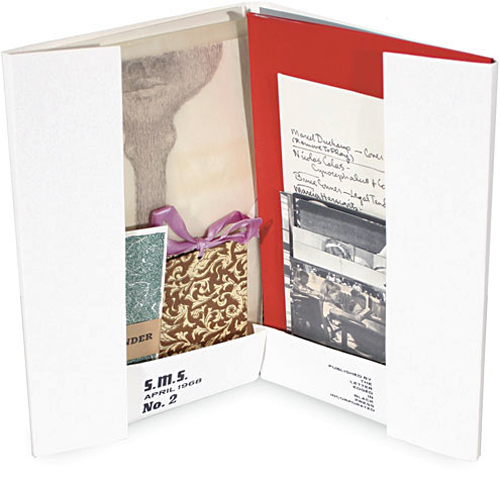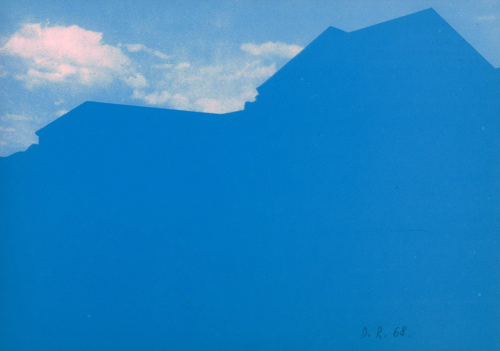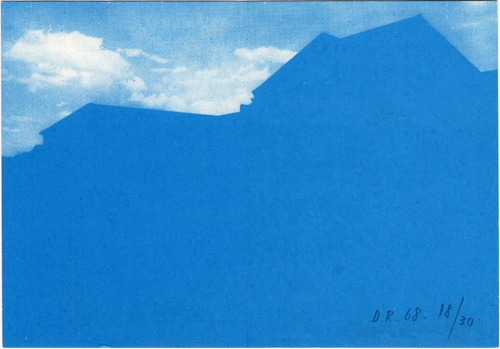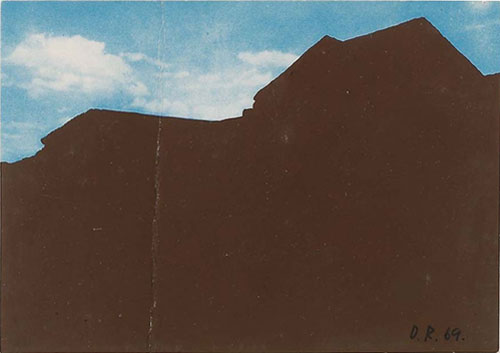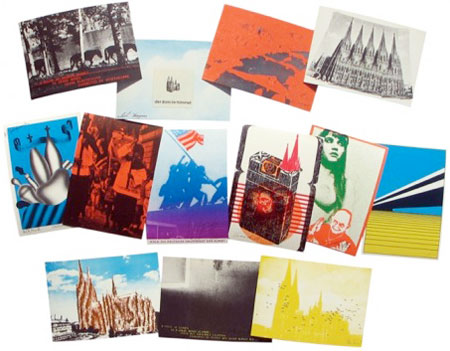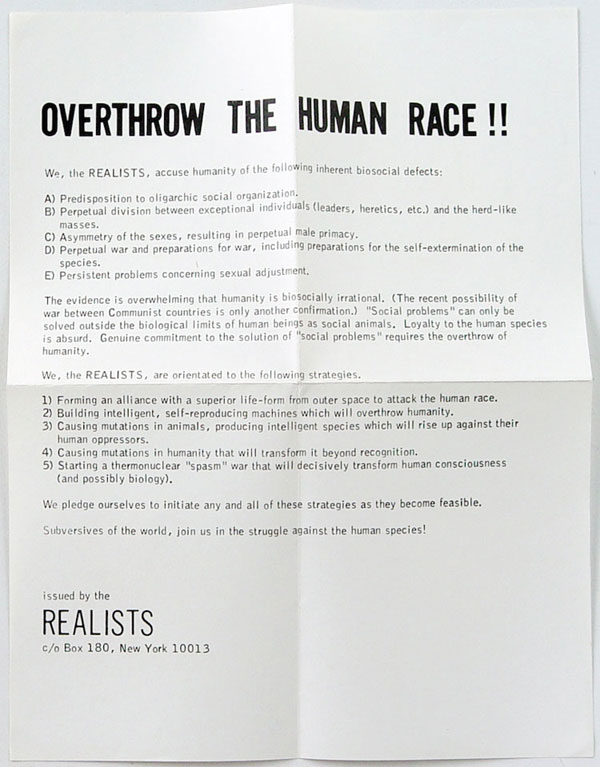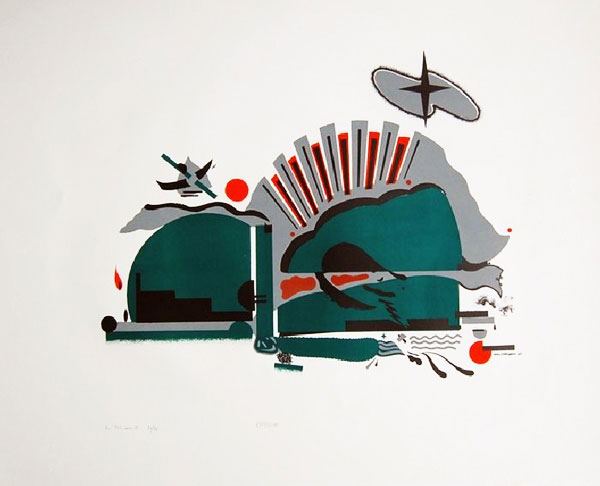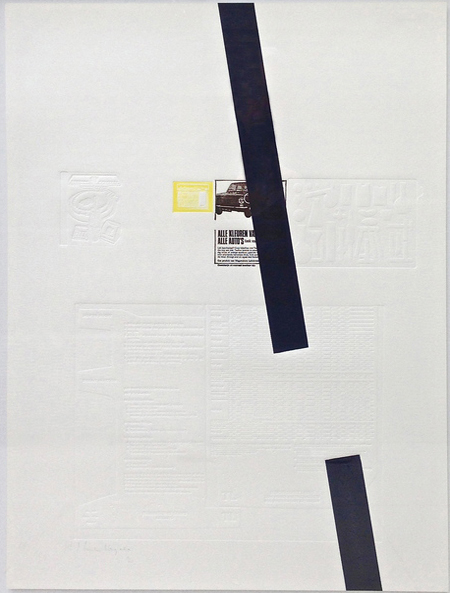ERIC ANDERSEN, Tape Piece, [1968]
three printed cards each 3 x 10,6 cm + piece from audio cassette tap in cellophane bag as published
this object is part of Ben Vautier’s magazine Fourre-Tout No. 3
edition 100 + 1 glass bottle with original manuscripts
published by Ben Vautier, Nice, France
Ref. Ben Vautier: Fourre-Tout No. 3, 1968
inv. BVau 220
Yearly Archives: 1968
BEN VAUTIER, Fourre-Tout No. 3, 1968 [magazine]
BEN VAUTIER, Fourre-Tout No. 3, 1968
CONTENU DE L’ENVELOPPE
18,9 x 17,4 cm
includes all objects, as issued
printed matter and objects in plastic envelope with hand numbered sticker
stamp numbered, here number 00016
6 parts and 1 printed list of contents with felt pen hand drawing of a bocal
edition 100
not available anymore
In an accompanying text of this issue it is announced by Ben and Annie (Noël) that “Fourre-tout” number 3 will be the last one. It is explained that ‘The content of this jar is learning us to admit everything. It reads the idea through the object.’
Issues number 1 and 2 were published in 1967 in an edition 250 each. A copy of issue number 3 is in the collection of the MoMA in New York, USA. The museum has one of the 100 glass jars in its collection that accompanies this periodical with an edition of 100 (+ 1 larger ‘jar’ with original manuscripts), although archived separately from its publication.
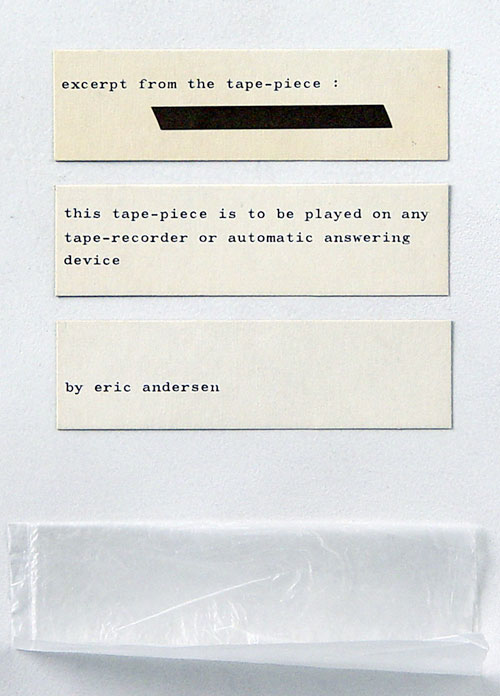
Complete content of original plastic envelope “Contenu de l’enveloppe”:
KEN FRIEDMAN – print with ink stamped text: Friedman’zart
HENRY FLYNT – print: Overthrow the Human Race!!
BEN VAUTIER – cut page with pencil drawn circles (recto verso) from paperback book
BEN VAUTIER – punched postcard called There might be an aeroplane in the sky of this tiny postcard
ERIC ANDERSSON [sic] – Tape piece, 3 tiny cards with texts/instruction + loose piece of tape
BEN VAUTIER/GEORGE MACIUNAS ? – small Fluxus bag with paste called A medicine for the asthma of Maciunas
Nota bene: This issue No. 3 is complete, although a glass jar the index is referring to as CONTENU DU BOCAL is lacking.
Extra information
Copy edition number 40/100 in the collection of the MoMa, New York. The glass jar with cork that is part of the publication has been archived by the museum separately.
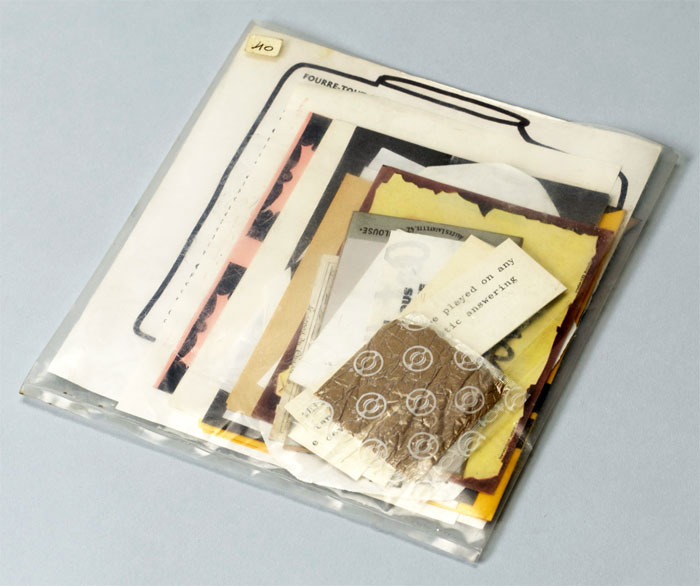
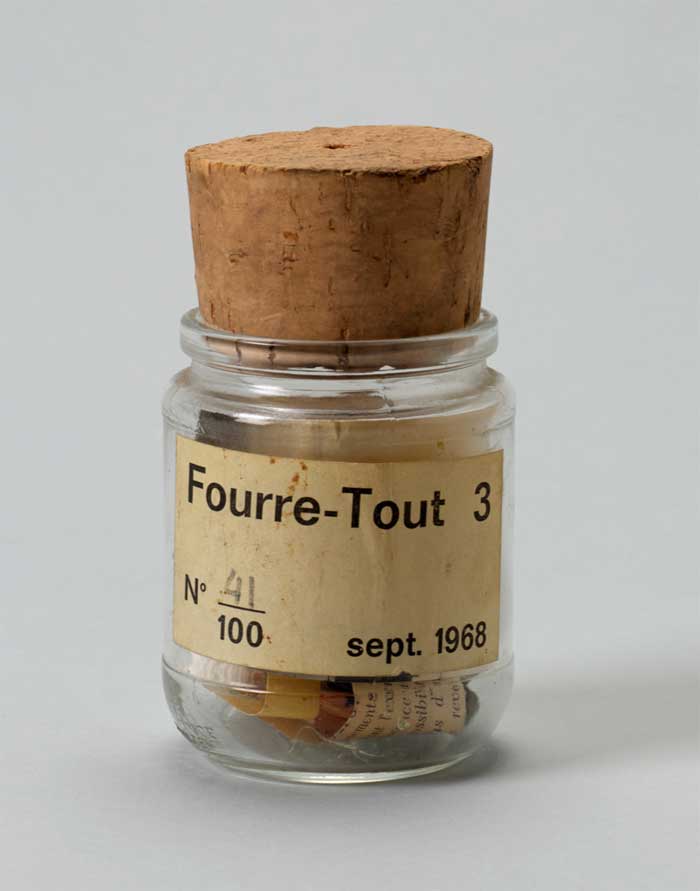
BEN VAUTIER, Fourre-Tout, No. 3, 1968
glass jar, label, felt-tip pen ink, cork, various objects
10,2 x 5,1 cm
being part of periodical
published by Ben and Anne Vautier
Collection MoMA, New York, USA
MARINUS BOEZEM, Windschaal, 1968
MARINUS BOEZEM, Windschaal, 1968
31 x 21,5 cm
stencil print, hand stamped address
signed in print
edition unknown
published by the artist
€ 1000,-
inv. MBoe 500
The subtitle of ‘Windschaal’ shown at the bottom of the stencil print is ‘Medium for stimulating renewed experiences’ (in Dutch: ‘Medium ter bevordering van hernieuwde ervaringen’). The print depicted below is in the collection of the MoMa in New York, acquired through Art & Project in Amsterdam.
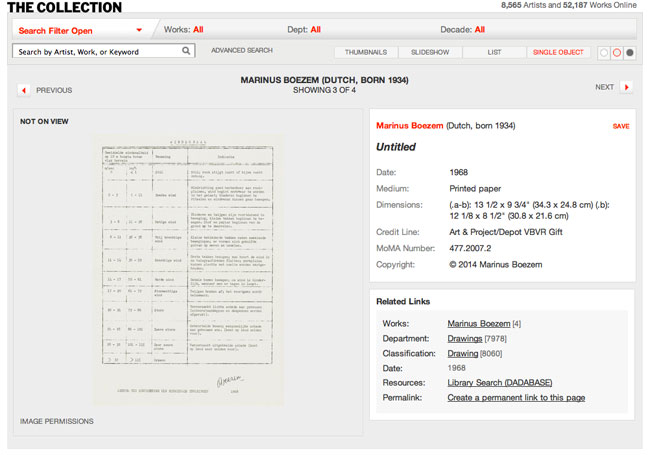
Collection MOMA, New York, USA
ROY LICHTENSTEIN, Folded Hat, 1968
ROY LICHTENSTEIN, Folded Hat, 1968
7.25 x 14 inches
offset on plastic foil
published by The Letter Edged in Black Press Inc. / William Copley, New York 1968
not available separately
This SMS edition is part of issue #4 and an offset print on plastic, sandwiched in plastic and hand-folded to form a tri-cornered hat.
MARCEL DUCHAMP, Contrepetrie, 1968 [vinyl record on empty portfolio]
MARCEL DUCHAMP, Contrepetrie, 1968 [vinyl record on empty portfolio]
ca 28 x 18 x 2 cm / ca 11 x 7 x 0.8 inches
relief letters Esquivons les ecchymoses des esquimaux aux mots exquis
vinyl record 7’0”, glued on relief print, stiff paper portfolio
edition ca 2000
published by The Letter Edged in Black Press Inc. / S.M.S. – William Copley, New York 1968
condition: pristine, although with a very light brownish horizontal line on cover
rare in this condition
€ 1.450,- plus € 18,- Track & Trace registered mail
inv.MDuc 000-pr
Sound record:
7′ recording of contrepetrie
This is one of the very last works that French artist Marcel Duchamp (1887–1968) created during his lifetime. It is a recording of his voice reciting French word games, known as contrepètries, which play with the sounds of words. The phonograph record presents an absurd alliterative sentence written in a spiral, that could translate to “We dodge the bruises of the Eskimos in exquisite words.”
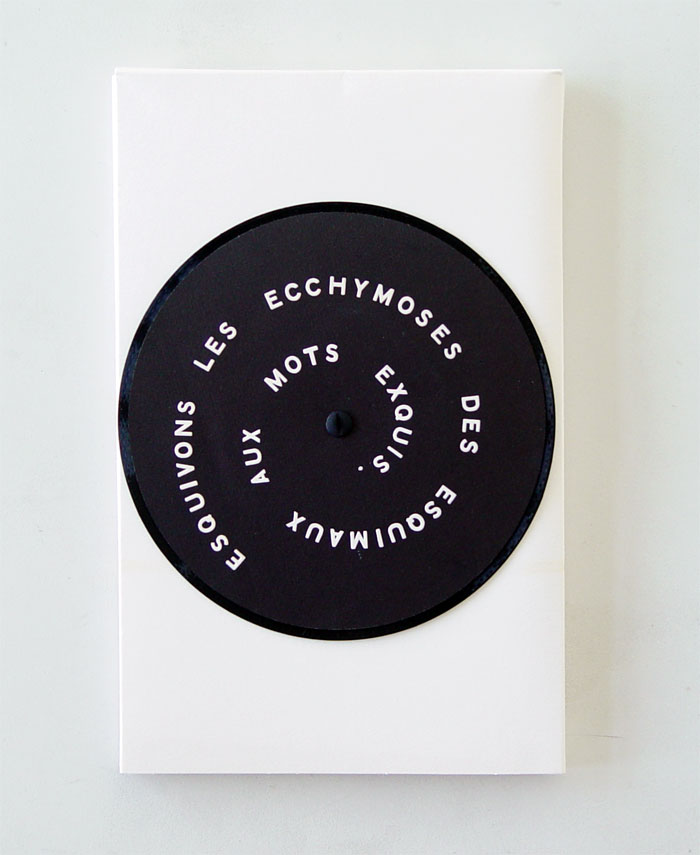
S.M.S., short for “Shit Must Stop,” endeavoured to do just that. Founded in New York City by artist, collector and dealer William Copley. S.M.S. was an art collection in a folio, filled with contributions of the artists invited by Copley. Regardless of stature, each was paid US$ 100,- for their contribution.
‘In 1967, in response to William Copley’s request to contribute to S.M.S., Duchamp gave him a sound recording (present location, unknown) he had made at an amusement booth around 1950. For the label of the record, they conceived of using a facsimile of one of the Disks Inscribed With Puns, 1926 (cat. no. 415-23), that Duchamp used in his film Anemic Cinema, 1926-26 (cat. no. 424).’ Arturo Schwarz
The SMS portfolios were a collaboration between William Copley & Dmitri Petrov which they published through their Letter Edged in Black Press Inc., working with some of the most important artists of the twentieth century. Exemplifying the community ethos of the ’60s, Copley sought to produce a new form of art journal that would bypass traditional institutions to distribute the artist’s work directly to its audience instead. Copley accepted contributions in almost any medium, carefully reproducing each artwork in his Upper West Side studio. All contributors, from the world-renowned to the obscure, received the same sum of $100 for their work. Presented without comment, each portfolio was mailed directly to subscribers every two months. Only six portfolios were produced, in an edition of 2000. Each portfolio contained from eleven to thirteen artist objects.
This SMS #2 edition is a seven-minute recording by Duchamp of “contrepetrie,” a word play involving transposing words, letters, and syllables and their sounds to make puns and effect new meanings. Record is part of S.M.S. magazine No.2 – April 1968.
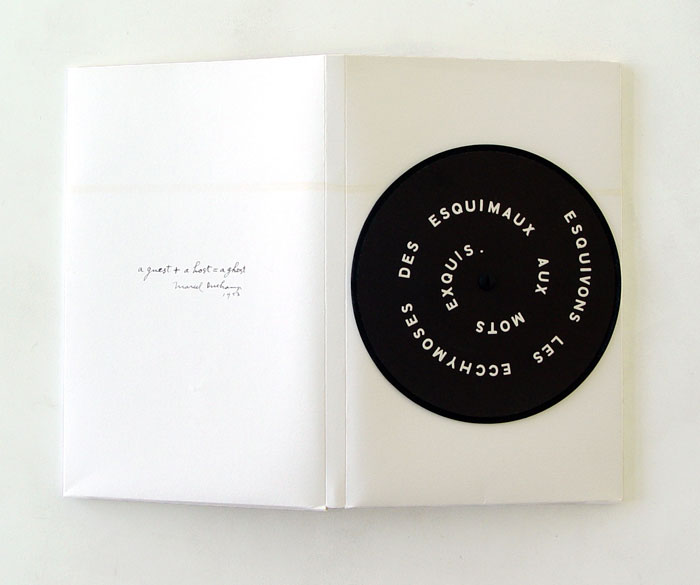
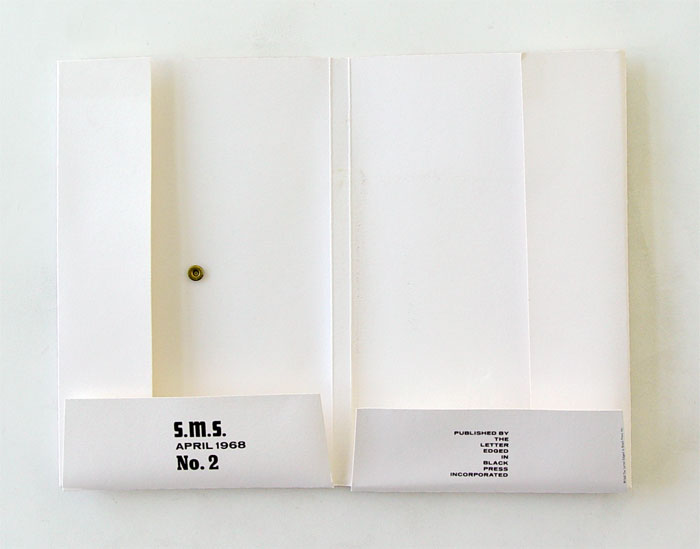
History of prices:
1stDibs, New York, USA € 5.346,- September 2023 (make offer)
eBay-feltown2015, Madrid, Spain € 1.400,- September 2023
Akim Monet Fine Arts, Dallas/Los Angeles, USA US$ 1,000.- September 2022
Gerrish Fine Art, England GBP 1,250.- March 2020
Akim Monet Fine Arts, Los Angeles, USA, April 2020, US$ 2,000.-
Stubbs Fine Art, UK, March 2020, GBP 950.-
Wright Auction, Chicago, USA, 18 January 2018, US$ 500.- incl. premium
_________________________________________________
Extra information:
Original content of the empty portfolio S.M.S. issue # 2 as shown above:
The magazine came in the shape of a white folder which contained art multiples – here not for sale – by the following artists:
1. Nicolas Calas 2. Bruce Connor 3. Marcia Herscovitz 4. Alain Jacquet 5. Ray Johnson 6. Lee Lozano 7. Meret Oppenheim 8. Bernard Pfreim 9. George Reavey 10. Clovis Trouille 11. Marcel Duchamp (the record).
Magazine cover reads “A guest + a host = a ghost, Marcel Duchamp 1953”.
Record is fixed with nut and bolt to the magazine.
Part of a folio of artist multiples, Marcel Duchamp’s piece works on at least two levels. One side of this disc features a short word game printed on black paper which covers the area of any grooves. The text “esquivons les ecchymoses esquimeaux aux mots exquis” (trans. ‘Let us dodge the bruises of the Eskimoes in exquisite words’). It is based on an element in Duchamp’s anagrammatically named filmplays on the similarity of the sound of words with quite different meaning and is one of the many circular texts seen rotating on similar discs in Duchamp’s film “Anemic Cinema”. The whole series of text is read by Duchamp on the opposite side of the disc in a 7 minute recording. While almost all are in French, Duchamp does include a single example in English: “my niece is cold because my knees are cold” which helps convey the sense of word play inherent in these pieces, and in fact in much of Duchamp’s work. The reading and circular representation of one of the texts display the circular aspects of these pieces which draw their sly humor from internal references within each stanza. While published in 1968, the recording sounds much older due to its thin quality, and may in fact have necessarily drawn from an archival source as Duchamp passed away that year. Adding to this, the record is haunted by a large amount of surface noise as the playing side was mounted directly to the folder cover enclosing SMS No. 2 leaving the surface exposed to more abuse. The combination of the fidelity and surface noise leaves the record sounding like an older 78 shellac disc even after extensively cleaning. Nonetheless, it is still an important document given the scant number of recordings of Duchamp’s calm speaking voice.
The work ‘Contrepetrie’ is mounted on a portfolio in which SMS # 2 was issued, being a part of the contribution to the magazine. Signed and dated in print verso on portfolio.
BRUCE NAUMAN, Footsteps, 1968 [sound piece on tape]
BRUCE NAUMAN
Footsteps, 1968
6,6 x 27,5 x 6,6 cm / 7.25 w x 11.75 h inches
offset, tape
edition 2000, of which 1500 have been in fact printed, including one hundred signed, portfolio #5
published by The Letter Edged in Black Press Incorporated, London, 1968
A loose piece of magnetic tape featuring sounds of walking wrapped around a triptych folded card with the following instructions:
Set the tape recorder for the speed indicated (3½)
Use a bottle or anything else you can think of to keep tension on the loop after you thread it on the machine (if there is no sound on the tape, it may be upside down)
Play the tape quite loudly for as long as you want or can stand
William Copley, American surrealist painter and art dealer, invited artists in 1968 to contribute to his periodical entitled S.M.S., which stood for “Shit Must Stop.” Copley was inspired by the Fluxus movement.
Decades later the factual printed edition of 1500 got water damaged which left most of the items of portfolio #5 to a total of ca 800 copies.
The Letter Edged In Black Press Inc.
American William Copley founded the publishing house The Letter Edged in Black Press Inc. that produced 6 SMS (abbreviation for “Shit Must Stop”) portfolios released in 1968. In addition to providing a place for artists to work, Copley published a series of artists’ multiples sold by subscription. The artists represented ranged from the very well known to less known artists, including Christian Henning, Ben Patterson, Dick Higgins, Christo, Walter de Maria, Julian Levy, La Monte Young, Marian Zazeela, James Lee Byars, Marcel Duchamp, Bruce Conner, Meret Oppenheim, Ray Johnson, Nicolas Calas, José Cortes, H.C. Westermann, Hannah Weiner, Allan Kaprow, Joseph Kosuth, Roland Penrose, Man Ray, Terry Riley, Dick Higgins, Enrico Baj, Roy Lichtenstein, Arman, John Cage, On Kawara, Robert Watts, Hollis Frampton, Yoko Ono, Mel Ramos, Lawrence Weiner, Angus MacLise, Bruce Nauman, Walter Marchetti, Dian Wakoski, Richard Artschwager, John Giorno, Diter Rot, Claes Oldenburg, and many other with an open mind, covering many areas of art. Among the 73 individual works, 6 involved sound, while the majority were visual or written works. Meticulously reproduced, each item was a distinctive artistic work giving each issue a widely varying character.
Ref. SMS nrs 1 – 6
DITER ROT (DIETER ROTH), Rathaus, 1968 [Serie 3: Kassel nr. 5]
DITER ROT (Dieter Roth), Rathaus, 1968 [Serie 3: Kassel nr. 5]
14,8 x 10,5 cm
offset postcard
out of set of 9 postcards, loose in original clear plastic envelope as issued
signed in initials, dated
published by Edition Tangente and distributed by Klaus Staeck, Heidelberg, Germany
€ 165,- plus € 13,- Track & Trace EU registered mail
References
“Exceedingly rare complete set of original postcards, published by Klaus Staeck in response to the controversial 4th Documenta show in Kassel in 1968. Each of the postcards is classified as an ‘Originalgrafik’, and this set includes Joseph Beuys’ very first artist postcard.
This set is special in the fact that every one of the postcards is individually signed by the respective artist. It is not known how many signed sets were ever issued, but it is probable that not more than ten such sets exist. Each postcard’s image is inspired by the Museum Fridericianum in Kassel.
List of the postcards:
Nr.1 Joseph Beuys – Friedrichsplatz (documenta IV) – signed in pencil. [Ref. Schellmann, Joseph Beuys – The Multiples, P1, page 410].
Nr.2 Gabor Altorjay – Kassel – documenta IV – 1968 – offset – signed in pencil
Nr.3 Gabor Altorjay – Kassel – documenta IV – 1968 – offset – signed in pencil
Nr.4 Karl Heinz Krull – Friedrichsplatz – 1968 – offset – signed and dated 68 in pencil
Nr.5 Dieter Rot – Rathaus – 1968 – offset – signed with initials and dated 68 in pencil
Nr.6 Klaus Staeck – Museum Fridericianum – 1968 – woodcut – signed and dated in pencil
Nr.7 Wolf Vostell – Multimedia Environment – Kassel 1968 – signed in pen
Nr.8 Nikolaus Jungwirth – Museum Fridericianum – 1968 – offset – signed in pencil
Nr.9 KP Brehmer – Museum Fridericianum – 1968 – offset – signed in pencil on reverse. This postcard also has Brehmer’s postage stamp which he designed for Documenta.”
Sims Reed Ltd., London, England
Nota Bene 1
DITER ROT (Dieter Roth), Rathaus, 1968 [Serie 3: Kassel nr. 5]
14,8 x 10,5 cm
offset postcard
out of set of 9 postcards, loose in original clear plastic envelope as issued
signed in initials, dated, numbered 1-30
part of ‘Vorzugsausgabe’
published by Edition Tangente and distributed by Klaus Staeck, Heidelberg, Germany
Nota Bene 2
DITER ROT (Dieter Roth), Rathaus, 1968 [Serie 3: Kassel nr. 5]
14,8 x 10,5 cm
scuffed offset postcard, painted, dated 1969
signed in initials
published by Edition Tangente and distributed by Klaus Staeck, Heidelberg, Germany
Nota Bene 3
The edition ‘Rathaus 1968, 9 postcards’ is not to be confused with ‘Heidelberg 1968, 14 postcards’; also published by Edition Tangente in 1968, Also as issued loose in original clear plastic envelope. (14.8 x 10.5 cm each).
Nr.1 Stefan Wewerka – Der Dom zu Köln im Jahre 5040 – offset – signed and dated in pencil on verso Nr.2 Dick Higgins – Der Dom im Himmel – 1968 – offset with collage element – signed in pen Nr.3 Gabor Altorjay – Köln Altstadt – offset – unsigned Nr.4 Karl Heinz Krull – 4711 immer dabei – offset – signed and dated 68 in pen Nr.5a Dieter Rot – Kölner Rheinbogen – offset – signed in pencil Nr.6 Klaus Staeck – Kölner Dom fur Raucher – woodcut – signed and dated in pen Nr.7 Wolf Vostell – Köln die deutsche Haupstadt der Kunst – signed in pen Nr.8 Nikolaus Jungwirth – Dom (ostseite) mit Rhein – offset – signed in pen Nr.9 Jean-Frederic Schnyder – Sieh Köln und Stirb – offset – signed in pen Nr.10 Werner Nöfer – Der Rhein bei Köln – offset – signed in pencil Nr.11 Friedrich Heubach – ziehen sie verbindungen – offset – signed in pen Nr.12 Alison Knowles – from the publication a house of dust – offset – signed in pen Nr.13 Alison Knowles – from the publication a house of dust – offset – signed in pen. Nr.14 Horst Antes – (Brief) – not issued. Nr.15 Joseph Beuys – Köln, signed in pen.
